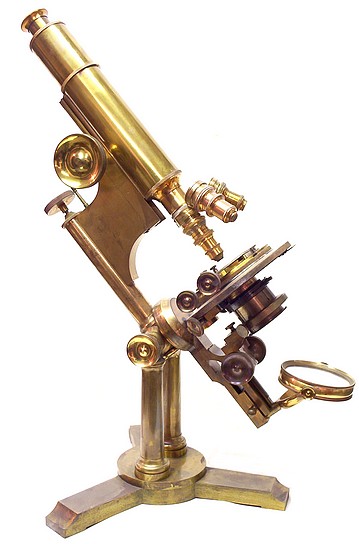
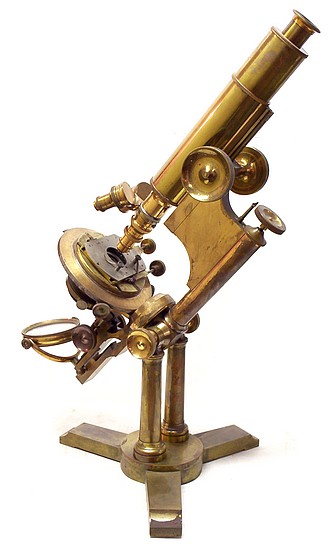
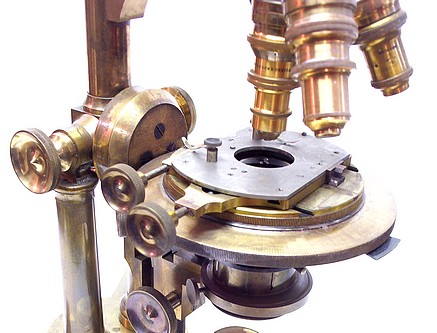
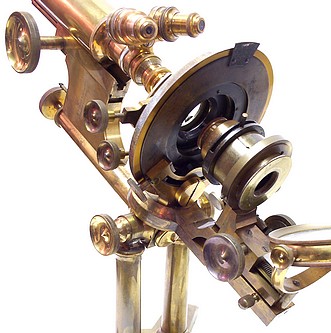
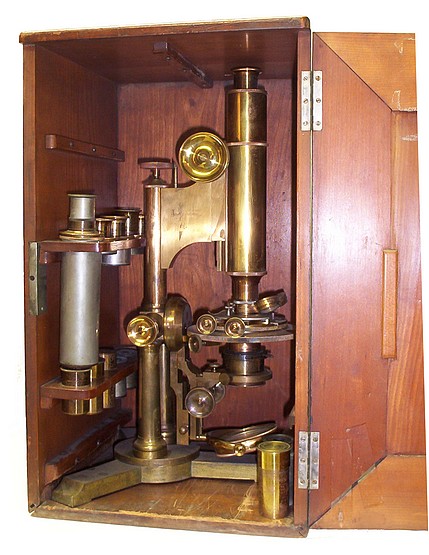
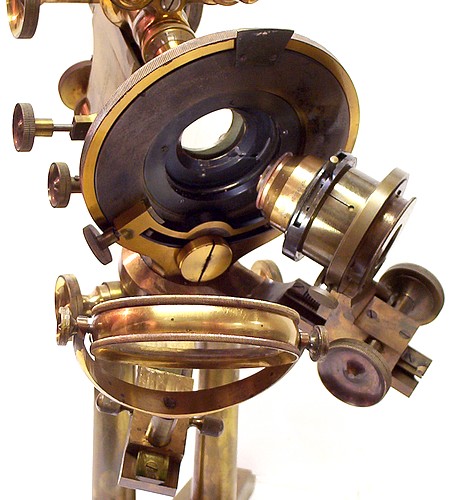
Extracted from The Journal of the Royal Microscopical Society, 1882:
Bausch and Lomb Optical Co.'s Professional Microscope. Fig. 113 (cut from America, is one of the best woodcuts of a Microscope which we have seen) shows the "Professional" Microscope of the above Company. Its specialities are the frictionless fine adjustment (described at p. 683), the glass stage and slide-carrier (described at p. 687), the centering of the substage (of which we have no detailed description), the two draw-tubes which allow of more than the ordinary variatious of length, and the mirror and substage bars which are separate and can be moved independently of one another, or simultaneously when the arm on the mirror is placed in a recess in the substage bar.
Bausch and Lomb Optical Co.'s Fine Adjustment. Fig. 126 represents the original of the fine-adjustment referred to at Vol. I. (1881) p. 110. Two strong parallel blades of finely tempered steel, a a, are securely fastened on one end to the back of case Fig. 126. d, on the other to the arm e, which carries the rack and pinion, b shows the micrometer screw, which is fitted to the upper part of the upright arm c, f is the pinion, g the rack and slide, h the tube. Two screws fasten the adjustment case d to the pillar c. An arm projects from the part e and passes into a recess in the pillar c. The springs support the entire body, and as their tension is upward, the projecting arm bears continually against the micrometer screw b, and it is evident that tho distance traversed by tho screw involves the same movement of the arm e, and consequently the body. The only points of contact are at the ends of the springs a, a, where they are fastened respectively at d and e, and on the micrometer screw, and as in the former there is absolutely no friction, there is no wear; while that which may eventually take place in the latter is taken up by the force of the springs.
The points of excellence claimed by the makers for this adjustment over all others, are the following: 1. It moves the entire body. 2. It is extremely sensitive and direct. 3. It has no lateral motion or displacement of the image, while adjusting. 4. It has absolutely no lost motion. 5. It can in no manner deteriorate.
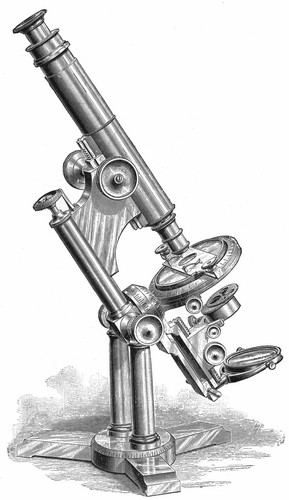
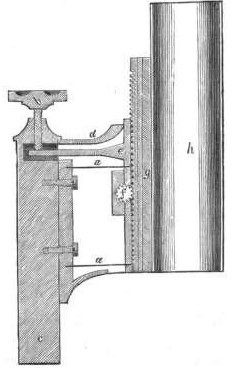
This model is described in the Sharp & Smith Catalog of Surgical Instruments, 1889 as follows:
PROFESSIONAL MICROSCOPE.
The design of this instrument is the result of studies covering a long period, and possesses all the features which our experience and knowledge of the wants of the public have been able to suggest. It is chaste and elaborate in all its details, and possesses a number of new features which enhance its value and which we believe entitle us to the claim that it is superior to any instrument designed for the same purpose.
It is constructed entirely of brass and stands about 18 inches high, when ordinarily in use. The upper part of one pillar is graduated and forms a valuable index for the point of illumination, when the body must be brought to the upright position, in changing immersion objectives. The coarse adjustment is by rack and pinion, the latter having specially large milled heads; the fine adjustment, by our patent frictionless motion; the milled head of the micrometer screw is graduated. The main tube has draw-tube and is provided with adapter having society screw; it has the same diameter as the substage, and thus permits the use of eye-pieces as condensers.
The mirror and sub-stage bar are separate and move independent of one another. Their axis, as well as the axis for inclination, are in the plane of the stage, so that when the body is inclined to the horizontal position, the center of the stage is in the axis of all the revolving parts. Both bars move freely in a circle around the stage and above it as far as the arm, and are provided with large graduated circles reading to degrees. They are arranged with stops which act when they are in line with the body, and move simultaneously when the arm on the mirror is placed in a recess in the sub-stage bar provided for it. The mirrors are plane and concave, of large size, and are adjustable along the mirror-bar, two milled heads being provided for convenience. The mirror frame may be replaced by a candle holder, for measuring the angular aperture of objectives. The sub-stage is of standard size, and is supplied with our patent Iris diaphragm; its distance from the object may be varied by rack and pinion movement, and may be entirely removed. It is provided with new centering adjustment.
The stage is 41/2 inches in diameter and is graduated to degrees on its beveled edge. It revolves upon a strong ring, which in turn is firmly held by a projecting arm. Three steel springs give it tension and insure its durability. These springs are arranged with slots, by which, after they are withdrawn from their recess, the stage may be removed. It is as thin as is consistent with firmness to allow great obliquity. The glass stage and slide-carrier is attached by a bayonet catch after removing the stage-plate. The centering adjustment of the stage as well as the sub-stage is effected by a new device which overcomes the difficulties of the methods hitherto used. Two screws, acted upon by two milled heads, promptly carry the stage to any point, where it is firm without requiring the use of binding screws.
This instrument is furnished in polished case, with drawer, receptacles for eye-pieces and objectives, handle, lock and key.
The history of the development of this microscope is described in the article:

